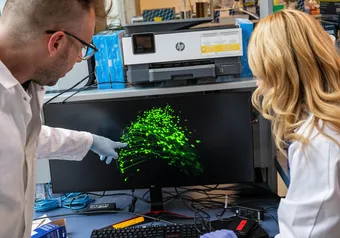The sympto-thermal method (STM) is an evidence-based fertility awareness technique that allows individuals to track their natural menstrual cycles, offering an alternative for those trying to conceive or avoid pregnancy.
Dr. Farah Shroff, a public health researcher and professor from UBC’s Department of Family Practice in the Faculty of Medicine, leads a research team that is exploring STM as a fertility awareness-based approach to contraception and family planning.
"The science behind the sympto-thermal method essentially relies on the high-fidelity relationship between cervical mucus and fertility," Shroff said. The menstrual cycle creates changes in this mucus, which indicate fluctuations in fertility. "The whole technique is based on identifying the ovulatory phase."
The STM offers a non-invasive, low-tech alternative to hormonal birth control and intrauterine devices. The method involves tracking cervical mucus and observing the mucus's consistency, texture, colour and smell. “When [an individual] urinates, she just has to look at the toilet paper and wipe the cervical mucus off the toilet paper and look at its [qualities] … It’s essentially like a science experiment — she is looking at her mucus every day and recording that,” said Shroff.
Alongside this, individuals track their basal body temperature using a specialized thermometer, which can be done by a partner to shift the responsibility away from being solely on the individual, according to Shroff. The third component, which is also often done by a partner, is checking the cervical os — the opening of the cervix — for changes in its position, openness and texture.
Shroff said she has used this method herself and first encountered STM while volunteering at the Vancouver Women's Health Collective. There, it was taught as a feminist tool for body literacy.
"Very few sort of messages in our world are about, ‘Hey, would you like to know about the rhythm of your body?’ ... Most of the messages we get are that these things are dirty and icky, [that] they smell bad," said Shroff.
Shroff and her team conducted research across Canada, focusing on people aged 15–45, to explore individuals’ experiences with contraception and their awareness of STM.
"We've interviewed about 60 people … The number one form of birth control they're using is the condom, and that's working quite well for them. And absolutely, the condom is a good form of birth control. It's excellent for sexually transmitted infection prevention,” said Shroff.
She also shared that many participants were unaware of STM but expressed interest when they learned more about it. STM's eco-friendly nature requires no packaging, no pharmaceuticals and minimal tools. Although STM has benefits, it remains relatively unknown among the general public.
"The first barrier is that very few people know about it. I have now been doing talks here in Canada … I have done some international webinars, and people from Europe, the African continent, Asia and Latin America who attended these talks … also knew nothing."
Factors such as limited awareness, lack of clinician training and minimal commercial investment have contributed to STM’s lower visibility in mainstream healthcare.
"It's not a money maker. You're teaching people how to do something. Once they learn how to do it, they could do it for life."
Her team aims to offer a series of three STM courses, including a certification course through UBC's Midwifery Program. Another one of these will be an online course designed for the general public, with the goal of making it widely accessible to learners around the world to ensure it's culturally inclusive and accessible. The third would be a science course geared toward secondary and post-secondary students, going through the menstrual cycle and the impact cyclical changes can have on fertility.
Shroff envisions a future where more individuals and couples can access this empowering, side-effect-free and sustainable approach to reproductive health.
"This technique offers people freedom … to be able to really enjoy their bodies, enjoy their sexuality, enjoy their fertility."
First online
Share this article









